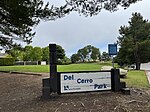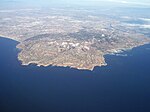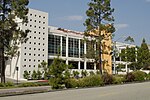Rancho Del Mar High School

Rancho Del Mar High School is one of three public high schools on the Palos Verdes Peninsula (the others being Palos Verdes Peninsula High School and Palos Verdes High School). Located on Crest Road in Rolling Hills, the school is part of the Palos Verdes Peninsula Unified School District. Rancho Del Mar was opened in 1984 on the former site of La Cresta Elementary School. With a relatively small enrollment, Rancho Del Mar High School focuses on students who experience difficulty with the regular high school environment or curriculum. It is a common secondary destination for those struggling with behavioral or academic issues at either Palos Verdes or Palos Verdes Peninsula High School. Enrollment is only granted through administrative recommendation.
Excerpt from the Wikipedia article Rancho Del Mar High School (License: CC BY-SA 3.0, Authors, Images).Rancho Del Mar High School
Oceanaire Drive,
Geographical coordinates (GPS) Address Nearby Places Show on map
Geographical coordinates (GPS)
| Latitude | Longitude |
|---|---|
| N 33.758257 ° | E -118.358756 ° |
Address
Oceanaire Drive
90275
California, United States
Open on Google Maps









